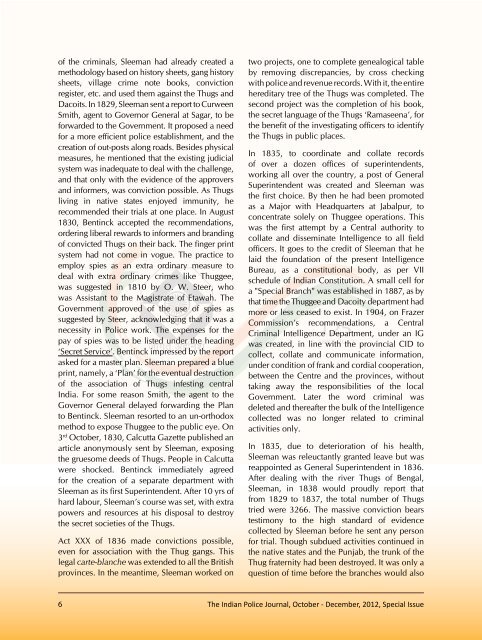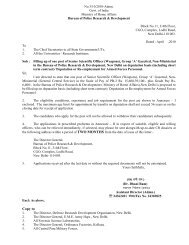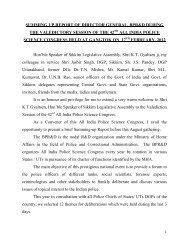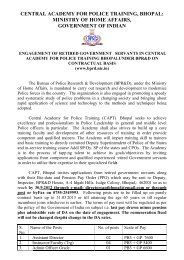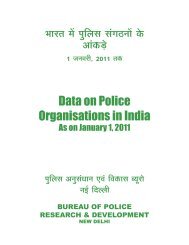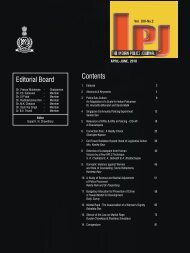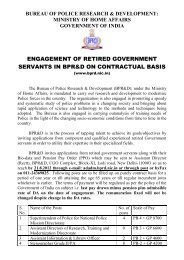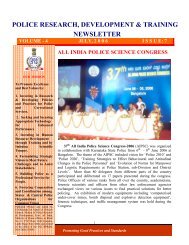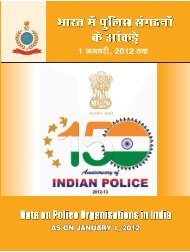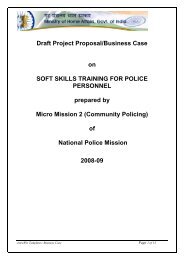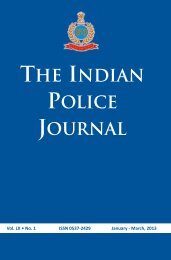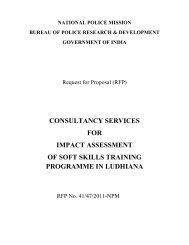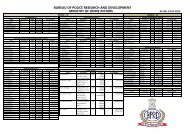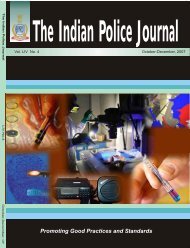<strong>of</strong> the criminals, Sleeman had already created amethodology based on history sheets, gang historysheets, village crime note books, convictionregister, etc. <strong>and</strong> used them against the Thugs <strong>and</strong>Dacoits. In 1829, Sleeman sent a report to CurweenSmith, agent to Governor General at Sagar, to beforwarded to the Government. It proposed a needfor a more efficient police establishment, <strong>and</strong> thecreation <strong>of</strong> out-posts along roads. Besides physicalmeasures, he mentioned that the existing judicialsystem was inadequate to deal with the challenge,<strong>and</strong> that only with the evidence <strong>of</strong> the approvers<strong>and</strong> informers, was conviction possible. As Thugsliving in native states enjoyed immunity, herecommended their trials at one place. In August1830, Bentinck accepted the recommendations,ordering liberal rewards to informers <strong>and</strong> br<strong>and</strong>ing<strong>of</strong> convicted Thugs on their back. The finger printsystem had not come in vogue. The practice toemploy spies as an extra ordinary measure todeal with extra ordinary crimes like Thuggee,was suggested in 1810 by O. W. Steer, whowas Assistant to the Magistrate <strong>of</strong> Etawah. TheGovernment approved <strong>of</strong> the use <strong>of</strong> spies assuggested by Steer, acknowledging that it was anecessity in <strong>Police</strong> work. The expenses for thepay <strong>of</strong> spies was to be listed under the heading‘Secret Service’. Bentinck impressed by the reportasked for a master plan. Sleeman prepared a blueprint, namely, a ‘Plan’ for the eventual destruction<strong>of</strong> the association <strong>of</strong> Thugs infesting centralIndia. For some reason Smith, the agent to theGovernor General delayed forwarding the Planto Bentinck. Sleeman resorted to an un-orthodoxmethod to expose Thuggee to the public eye. On3 rd October, 1830, Calcutta Gazette published anarticle anonymously sent by Sleeman, exposingthe gruesome deeds <strong>of</strong> Thugs. People in Calcuttawere shocked. Bentinck immediately agreedfor the creation <strong>of</strong> a separate department withSleeman as its first Superintendent. After 10 yrs <strong>of</strong>hard labour, Sleeman’s course was set, with extrapowers <strong>and</strong> resources at his disposal to destroythe secret societies <strong>of</strong> the Thugs.Act XXX <strong>of</strong> 1836 made convictions possible,even for association with the Thug gangs. Thislegal carte-blanche was extended to all the Britishprovinces. In the meantime, Sleeman worked ontwo projects, one to complete genealogical tableby removing discrepancies, by cross checkingwith police <strong>and</strong> revenue records. With it, the entirehereditary tree <strong>of</strong> the Thugs was completed. Thesecond project was the completion <strong>of</strong> his book,the secret language <strong>of</strong> the Thugs ‘Ramaseena’, forthe benefit <strong>of</strong> the investigating <strong>of</strong>ficers to identifythe Thugs in public places.In 1835, to coordinate <strong>and</strong> collate records<strong>of</strong> over a dozen <strong>of</strong>fices <strong>of</strong> superintendents,working all over the country, a post <strong>of</strong> GeneralSuperintendent was created <strong>and</strong> Sleeman wasthe first choice. By then he had been promotedas a Major with Headquarters at Jabalpur, toconcentrate solely on Thuggee operations. Thiswas the first attempt by a Central authority tocollate <strong>and</strong> disseminate Intelligence to all field<strong>of</strong>ficers. It goes to the credit <strong>of</strong> Sleeman that helaid the foundation <strong>of</strong> the present Intelligence<strong>Bureau</strong>, as a constitutional body, as per VIIschedule <strong>of</strong> Indian Constitution. A small cell fora "Special Branch" was established in 1887, as bythat time the Thuggee <strong>and</strong> Dacoity department hadmore or less ceased to exist. In 1904, on FrazerCommission’s recommendations, a CentralCriminal Intelligence Department, under an IGwas created, in line with the provincial CID tocollect, collate <strong>and</strong> communicate information,under condition <strong>of</strong> frank <strong>and</strong> cordial cooperation,between the Centre <strong>and</strong> the provinces, withouttaking away the responsibilities <strong>of</strong> the localGovernment. Later the word criminal wasdeleted <strong>and</strong> thereafter the bulk <strong>of</strong> the Intelligencecollected was no longer related to criminalactivities only.In 1835, due to deterioration <strong>of</strong> his health,Sleeman was releuctantly granted leave but wasreappointed as General Superintendent in 1836.After dealing with the river Thugs <strong>of</strong> Bengal,Sleeman, in 1838 would proudly report thatfrom 1829 to 1837, the total number <strong>of</strong> Thugstried were 3266. The massive conviction bearstestimony to the high st<strong>and</strong>ard <strong>of</strong> evidencecollected by Sleeman before he sent any personfor trial. Though subdued activities continued inthe native states <strong>and</strong> the Punjab, the trunk <strong>of</strong> theThug fraternity had been destroyed. It was only aquestion <strong>of</strong> time before the branches would also6The Indian <strong>Police</strong> Journal, October - December, 2012, Special Issue
perish. Between 1841 <strong>and</strong> 1848, another 514Thugs had been convicted. Thuggee ceased toexist after 1848. In the Central provinces Thugsremained a column in the annual crime statisticsupto the year 1900. In 1904, only 2 cases werereported in India.Though Sleeman was nicknamed ‘ThuggeeSleeman’, it would also be more appropriate tocall him ‘Thuggee <strong>and</strong> Dacoity Sleeman’. Forin the year 1839, another feather was addedto his cap. He was to face another challengefor which he was well prepared. Sleeman wasnow made Commissioner, in addition to his jobas Superintendent <strong>of</strong> the Thuggee Department.The new department came to be known as the"Department for the suppression <strong>of</strong> Thuggee <strong>and</strong>Dakaity". Sleeman shifted his headquarters fromJabalpur to Moradabad. In the year 1839, therewere wide spread depredation by Badhak dacoitsin Northern India, from Jamuna to Kosi, <strong>and</strong> fromHimalayas to Narmada. There was terror <strong>and</strong> fearamongst the people, ‘no one seemed to knowfrom whence they came <strong>and</strong> whence they fled’.Treasuries <strong>of</strong> native Collectors had to be fortified.The Badhaks were well organized, numberingupto 10,000 dacoits in the region. Sleeman hadalready had a taste <strong>of</strong> Badhaks at Narsinghpurin 1824, <strong>and</strong> since then, besides investigatingThugs, he was also investigating the Badhakdacoits. Sleeman immediately went into actionagainst the dacoits <strong>and</strong> adopted the same tactics,as he had done against the Thugs, includingreformatory measures. He set up a colony forthe dacoits named Badhakpura at Moradabad.Sleeman had to adopt harsh measures against thedacoits due to the organized <strong>and</strong> deceptive ways<strong>of</strong> the Badhaks. Army was called out againstthem. One Mangal Singh in Oudh area <strong>and</strong> GajrajSingh in Chambal area <strong>of</strong> Gwalior, Dholpur <strong>and</strong>Alwar had created a reign <strong>of</strong> terror. The Sarafa<strong>of</strong> Jhansi, Peshwas palace at Bhithur, Kanpur<strong>and</strong> several other big <strong>and</strong> small towns werelooted <strong>and</strong> ransacked. In the Central Province,the towns <strong>of</strong> Narsinghpur, Hoshangabad <strong>and</strong>Sohagpur were also looted. Enroute, no treasurywas safe from these dacoits. Sleeman fell on theBadhaks like a tornado <strong>and</strong> by 1842, all majorgangs <strong>and</strong> their members were either arrested,killed or had surrendered. By comparison, it isrealized that in the same Chambal region, twelveto thirteen Batallions <strong>of</strong> Special Armed forces<strong>of</strong> MP, UP <strong>and</strong> Rajasthan had been engaged forover twenty years since 1951, till the surrender <strong>of</strong>the 23 listed gangs <strong>of</strong> Madhya Pradesh, in 1972.In fighting the descendants <strong>of</strong> the Badhak gangs,Sleeman’s achievement in two years st<strong>and</strong>s outin bold contrast. Sleeman’s strength lay in theintelligence collected with meticulous care <strong>and</strong><strong>of</strong> very high st<strong>and</strong>ard <strong>of</strong> accuracy, before hestruck against the gangs.It was at district Sagar in the year 1973, whileinvestigating a case <strong>of</strong> dacoity, I came across areport on 'Budhuk @ Bagree Decoits <strong>and</strong> OtherGang Robbers' <strong>and</strong> on the measures adopted bythe Government <strong>of</strong> India for their suppression byLt. Col. W H Sleeman. Although the report wassent to the press in 1840, the Governor General,Lord Auckl<strong>and</strong> felt that the proper time for itspublication had not arrived. It is believed thatthe report, which highlighted the existence <strong>of</strong>hereditary gangs <strong>of</strong> robbers <strong>and</strong> dacoits <strong>and</strong> theirdepredations would show the East-India companyin a bad light before the English Parliament <strong>and</strong>the Crown. It was finally published in 1849.Sleeman, in a forwarding letter to H. M. Elliot,Secretary to the Goverment <strong>of</strong> India, had opinedthat this was the last elaborate report on crimein India. Sleeman was correct, because afterSleeman, to this day, no person or organizationin India, connected to crime, has ever come outwith such a report. It goes to the credit <strong>of</strong> theIntelligence <strong>Bureau</strong> that after Independence, itpublished a “Report on the Criminal Activities onInter –State Gangs <strong>of</strong> Bawarias”. Sleeman had theadvantage <strong>of</strong> being familiar with acts, thoughts<strong>and</strong> feelings <strong>of</strong> persons involved in crime. Hehad foresight, <strong>and</strong> he expressed his apprehensionthat though Thuggee had been suppressed, it wassure to rise again, if the police was negligent.The report was an eye opener for me, which setme on my course in <strong>Police</strong> career to study theCriminal Tribes.As a reward, Sleeman was first given an additionalcharge to look into the affairs <strong>of</strong> GwaliorState, which was in bad shape. He supersededCavindich, the Resident at Gwalior who was afriend <strong>of</strong> Bentinck. Sleeman made Jhansi hisThe Indian <strong>Police</strong> Journal, October - December, 2012, Special Issue 7
- Page 1 and 2: The Indian Police JournalOctober -
- Page 3 and 4: From the Director’s DeskNew Delhi
- Page 5 and 6: 23rd December, 1887: TheJourney beg
- Page 7 and 8: Courtesy - National Archives of Ind
- Page 9 and 10: The Logo released on the completion
- Page 11 and 12: Helmsmen of the IB during thePre-In
- Page 13 and 14: SHRI V.G. VAIDYA, IPS(MAR 1992 TO J
- Page 15 and 16: “Sleeman sahib ki jai”“No Cri
- Page 17 and 18: their life and their problems relat
- Page 19: Settling down of criminal tribes wa
- Page 23 and 24: In conclusion, I would like to reco
- Page 25 and 26: own race alone, had to be withdrawn
- Page 27 and 28: a bee in his bonnet” 17 , and abo
- Page 29 and 30: epresented by Tilak and his followe
- Page 31 and 32: The agency more and more fine-tuned
- Page 33 and 34: US was brewing, one William Hopkins
- Page 35 and 36: came under the control of Indian mi
- Page 37 and 38: neutralised many efforts by inimica
- Page 39 and 40: e published by the Intelligence Bur
- Page 41 and 42: As DD (Security), IB, I had occasio
- Page 43 and 44: Chhomohlohri, all of them juxtapose
- Page 45 and 46: Dormers Building, ShimlaThe Dormers
- Page 47 and 48: eforms. Warren Commission, on the a
- Page 49 and 50: and systems will increasingly come
- Page 51 and 52: violence and destabilisation. This
- Page 53 and 54: one develop. The all pervasive cult
- Page 55 and 56: etween the states and the centre su
- Page 57 and 58: Intelligence Agencies inIndian Demo
- Page 59 and 60: Democracies are, today, everywhere
- Page 61 and 62: depend substantially on the restrai
- Page 63 and 64: Of Pistols and Pigs andthe Old Tidd
- Page 65 and 66: it is lovingly caressed hundreds of
- Page 67 and 68: Through the Eyes of an IB OfficerSh
- Page 69 and 70: an Intelligence agency. He used to
- Page 71 and 72:
My J&K ExperienceShri R.K. Kapoor,
- Page 73 and 74:
there. We remained stranded there f
- Page 75 and 76:
Scaling Himalayan Heights withthe I
- Page 77 and 78:
proceed to Dungti to supervise the
- Page 79 and 80:
tour of the White House and Lincoln
- Page 81 and 82:
into unconsciousness two hours earl
- Page 83 and 84:
which was completed successfully wi
- Page 85 and 86:
leaders. This happened around the t
- Page 87 and 88:
My Unforgettable Yearsin the North-
- Page 89 and 90:
stated that Prakash Singh, Assistan
- Page 91 and 92:
take her into confidence. That woul
- Page 93 and 94:
Police - Intelligence InterfaceShri
- Page 95 and 96:
Shreekant Bapat and I surveyed the
- Page 97 and 98:
excellence, dedication and commitme
- Page 99 and 100:
Immigration, Inter-State Disputes,
- Page 101 and 102:
Observations on India’s State and
- Page 103 and 104:
assessments that arose after the ca
- Page 105 and 106:
levels. The deficiencies of one par
- Page 107 and 108:
of laying a network of useful roads
- Page 109 and 110:
Technology in Intelligence-Future S
- Page 111 and 112:
These are just some of the aspects
- Page 113 and 114:
Figure 6: Open Source Information o
- Page 115 and 116:
events) and inference from evidence
- Page 117 and 118:
9North Atlantic Treaty Organization
- Page 119 and 120:
Shri Dave was posted back to the lB
- Page 121 and 122:
He even suggested separate pay scal
- Page 123 and 124:
The Unsung HeroesThe Intelligence B


